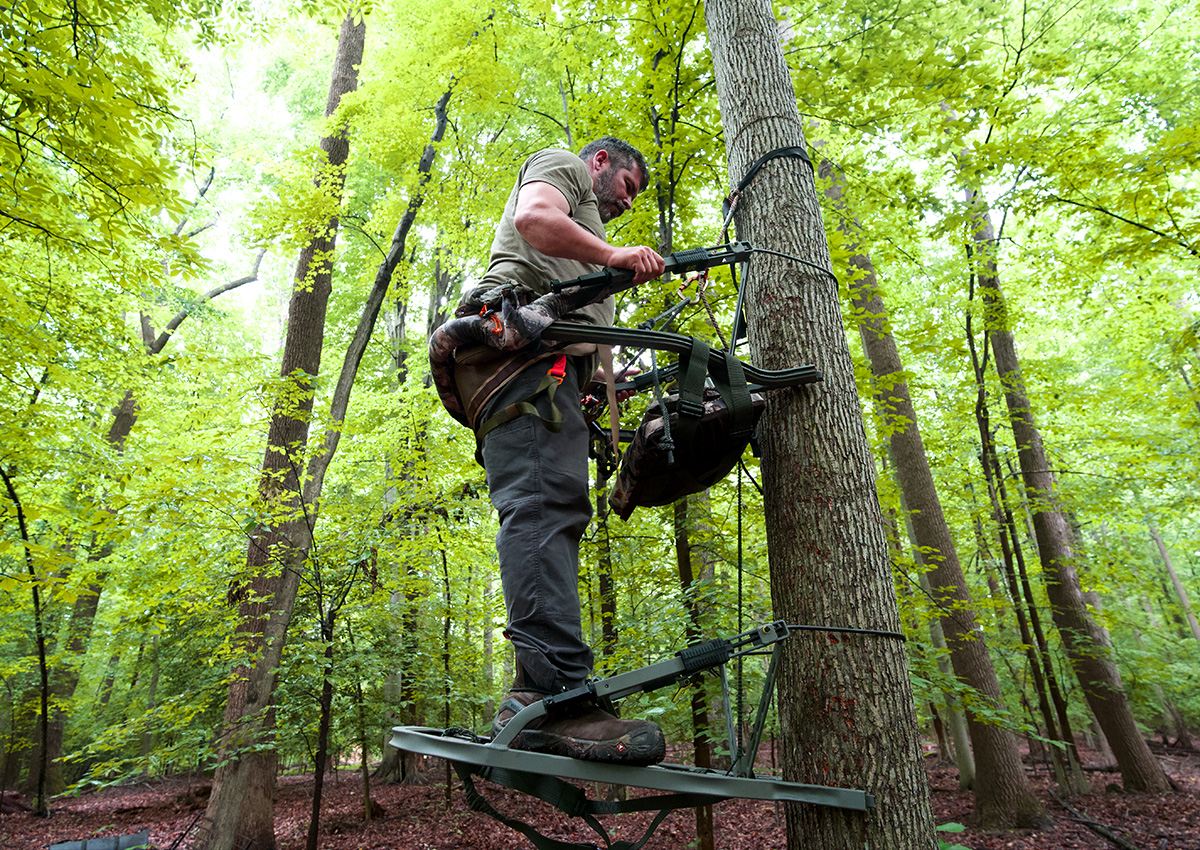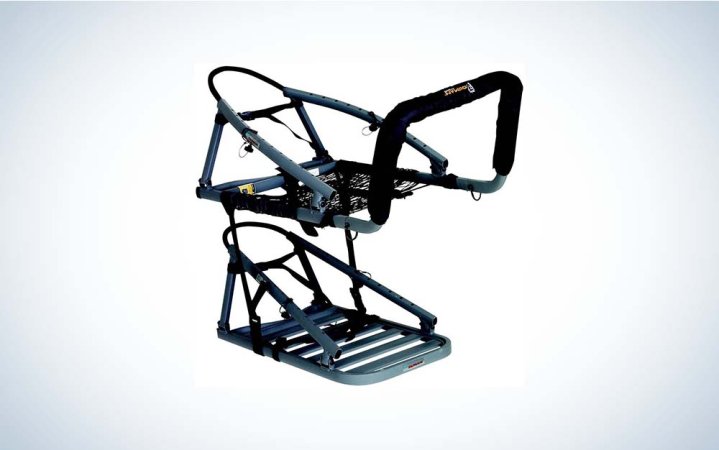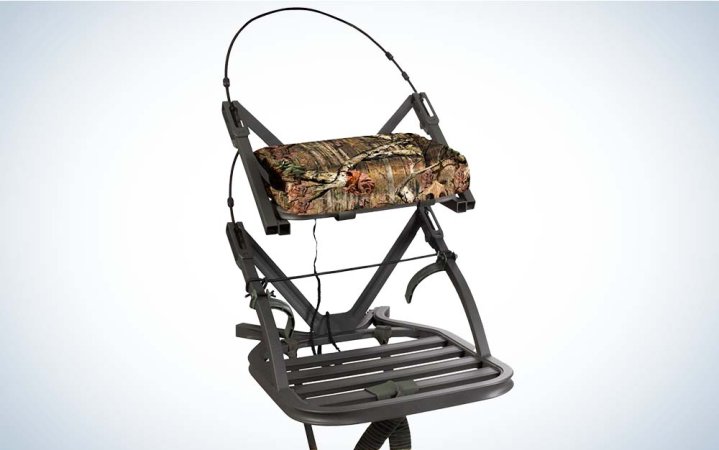We may earn revenue from the products available on this page and participate in affiliate programs. Learn More ›
Climbing tree stands allow you to get mobile and hunt tucked-away spots that are too far from the trail for a ladder stand to be a feasible option. They also allow you to adjust your setup during a hunt if you realize that the deer traffic happens to be just out of range. And unlike hang-on tree stands that require several climbing sticks, climbers only have two main pieces that you have to worry about.
With the exception of strategic ground setups, I’ve hunted almost exclusively from a climber for more than a decade. I leave one in my trunk, and it’s ready to go whenever I bounce between different hunting spots. They’re also my preference when I hunt my family’s property, especially during the late season when pressured deer start utilizing new parts of the property, and I need to make a quick adjustment. Over the years, I’ve used climbers from several different brands and the best ones allow you to slip into your hunting spot without announcing your presence to the entire woods or making you feel like you just finished a deer drag before you’ve even punched your tag. For this review, we tested the best climbing tree stands for comfort, climbing, noise, and packability to help you find the best option.
- Best Packability: Ol’ Man Alumalite CTS
- Best for Minimalists: Summit Openshot SD
How We Tested the Best Climbing Tree Stands
During the test we evaluated each stand to see how well they packed, their overall comfort, and how much noise they produced during the packing and climbing portions. Each portion of the test was graded on a scale of one to five, with five being the best. We also timed how long it took to set the stand up and climb 10 feet up a tree.
Typically, for tests like these we include, at minimum, five products. Unfortunately, we were unable to test more than two climbing tree stands. While product availability played a small role in this, the main reason is that there aren’t a ton of climbing tree stand manufacturers. So, in addition to the two products we were able to test, we also included three picks to help cover other hunting styles or scenarios that whitetail hunters might encounter, as well as a budget pick.
The Test Team
Billy Philips: Is an urban bowhunter who has the opportunity to hunt 365 days a year and takes full advantage of those opportunities with 150 days spent in a stand or saddle.
Josh Philips: Like his brother Billy, Josh is a four-season bowhunter with over 100 days spent in stands and saddles each year.
Scott Einsmann: Outdoor Life‘s gear editor and experienced mobile hunter.
Packability
For the packability test we set up each stand in its pack configuration. Then, a tester carried a stand through the woods. The two testers that weren’t carrying stood along the trail, listening for any noise made by the stand. We also carried the stands through thick woods to see if any part of the stand caught on brush. Each tester gave a score for packability from one to five, with five being the best.
Climbing
For the timed climbing test, a tester started at the bottom of the tree with the stand on their back. Once the timer started, they set up the stand and climbed to ten feet (height from the ground to the platform), while the other testers at the base of the tree noted how much noise the stand produced.
Comfort
Testers rated the comfort of the stand during the packability and climbing portions of the test. The backpack straps, seat cushions, and comfort during carry were all evaluated and rated on a scale of one to five, with five being the highest.
Best Climbing Tree Stands: Reviews and Recommendations
Best Packability: Ol’ Man Alumalite CTS
Pros
- Packs great
- Super comfortable seat
- Feels lighter than its actual weight
Cons
- Noisy setup
Key Features
- Platform Size: 18 inches by 32 inches
- Wide net seat
- Reversible gun rest/footrest
- Material: Aluminum
- Weight: 21 pounds
- Weight Limit: 300 pounds
If you want a climber that you can carry to deep public holes, the Ol’ Man Alumalite CTS won’t wear you down by the time you get there. Its narrow profile, which folds flat, made it much easier to navigate through thicker cover. The less bulky design and the fact that its weight sits closer to your body, gave the Ol’ Man an edge on the Summit for packability. While packing, the loose cables on the Ol’ Man created a lot of noise, but with extra bungees, you can make this stand much quieter and mitigate a lot of the rattle from the loose cables during packing.
For the climbing portion, much of the noise was made during set up, which ultimately led the testers to give the Ol’ Man a 2.5 out of five for the climbing noise test. Once off the ground, it was just as quiet as any climber. One thing we appreciated was the knobs attached to the pins which tightened them in place, eliminating rattle. The Ol’ Man took just under five minutes to go from packed to on the tree. Unlike the Summit, which required minimal time to start climbing, the Ol’ Man took another five minutes for testers to adjust and start climbing. All the testers were unfamiliar with this stand, and more practice with it would certainly cut down on this time. One of the main hang-ups are the cables, which have a narrow hole and require near perfect alignment for the pins to fit. This was hard enough in the daylight, so expect to spend even more time on this in the cold and dark. But once ready, the Ol’ Man only required 1 minute and 30 seconds to reach the 10-foot mark, exactly half the time of the Summit.

Though overall noisier than the Summit, the Ol’ Man proved quiet once on the tree. The folding handrails made testers feel uneasy while climbing, even though this design supposedly tightens the steel cable’s grip on the tree while doing so. These handrails also tighten down when you sit, increasing the snug grip on the tree throughout your hunt. This feature is okay for medium- and small-stature hunters but probably won’t work for larger people, as it folds down a little too close.

The low-profile seat allows you to easily push it back toward the tree if you need to stand and make a shot, but this feature sometimes works too well, and you have to hold the seat while you sit so it doesn’t slide back. Gear editor Scott Einsmann, who tips the scales at 230 pounds, tested the security of the Ol’ Man by jumping up and down, and it didn’t flex. The Ol’ Man might make more noise than the Summit, but it’ll save you around $200 at almost half the price.
Ol’ Man Alumalite Scores
Packability: 4
Comfort: 4
Noise: 2.5
Set up and climbing time: 11 minutes, 9 seconds
Best for Minimalists: Summit Openshot SD
Pros
- Plenty of room for longbows
- Compact
- Lightweight
- Quiet
Cons
- Seat might be too narrow for bigger hunters
Key Features
- Platform Size: 20 inches x 32 inches
- Foam-padded folding seat
- Open-front design
- Adjustable backpack straps
- Material: aluminum
- Weight: 15 pounds
- Weight Limit: 300 pounds
If you’ve ever bowhunted from a climber, even with the shortest bows, then you know it can feel like a delicate dance when you’re trying to draw on a deer, not bump your stand, and remain undetected. Thankfully, the Summit Openshot ditched the front rail and added a super padded and foldable seat that’s comfortable and silent when it’s time to get in position and let an arrow fly. This seat isn’t the widest, so it might not accommodate larger hunters. No rail means you can get to full draw without maneuvering around your stand, even with a longbow.
At 15 pounds, this climber weighs less than any other stand in the review, which makes it a viable option for packing longer distances. If you’re looking for a middle ground between a hang on and a climber, the Openshot hits that sweet spot.
FAQs
The best tree stand brand for climbers, consisting of most of the climbing stands on the market, is Summit.
While this might vary slightly, most climbing tree stands hold anywhere from 250-350 pounds, but most of them carry a 300-pound max weight limit.
A climbing tree stand typically utilizes rubber-coated steel cables to connect the lower and top portions of the stand to a tree. These cables wrap around a tree and lock into both sides of the stand on the top climbing portion and bottom platform. Once connected to the tree, a hunter will slide their feet under the stirrups or foot straps on the bottom portion, which they use to move the stand up the tree as they climb (with one of the best tree stand harnesses and lineman’s belt, of course). Climbing stands have teeth that wedge or bite into the tree as the hunter climbs, creating a tight, secure fit around the tree that is reinforced by the hunter’s own bodyweight. Once at hunting height, you can secure the attached seat (if applicable) to the tree, typically via a bungee or buckle strap. The top portion typically rests at a height that allows you to sit on the attached seat with your feet resting on the bottom platform in a comfortable, seated position. Climbers usually incorporate some type of bungee cord or strap that tethers both the top and bottom together. You then have the option to sit or stand in the climber periodically.
The Future of Climbing Tree Stands
If you’re wondering why we only tested two climbing stands, it wasn’t for lack of trying to get products. And despite the recent product shortages across all manufactured goods, product availability didn’t play a significant role in this absence either. The reality is, there just aren’t a ton of companies manufacturing climbing stands like there were 10 to 20 years ago. In fact, Summit manufactures most of the climbing stands that are available today. Sure, we could have easily tested five different Summit stands, but that’s not exactly a fair assessment of the other manufacturers out there.
Perhaps the lack of climbing tree stands marks a shift in the trajectory of stand preference for hunters. Like most hunting products and gear (there are exceptions of course), “lightweight” tends to carry a lot of weight with hunters. And climbing stands, even the lightest ones, are anything but lightweight compared to options like tree saddles. If you piece your kit together strategically, you can build a mobile hunting stand that weighs less than 10 pounds. That’s five pounds lighter than the lightest climbing stand in this test. Not to mention, nylon won’t announce your presence to the entire woods if you bump against a tree on the way to your setup. And most of these, with the exception of multiple climbing sticks, you can stow in some of the best bowhunting backpacks.

I don’t see climbing tree stands going away anytime soon, but tree stand manufacturers aren’t in an arms race to produce new ones either. That being said, there are still plenty of solid options out there, and these stands definitely have their place.
Final Thoughts on the Best Climbing Tree Stands
The best climbing tree stands can simplify your stand placement this fall. Whether you’re hunting a deep public honey hole or a generational family spot, you can find a climber in this review that fits your budget and preference. Then it’s up to you to find the right tree.


